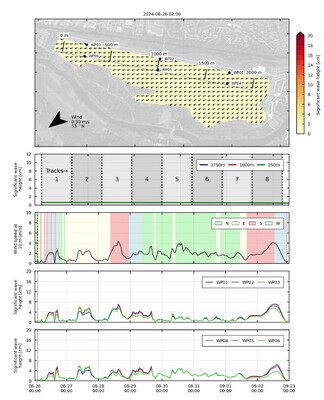R.van der Neut1*, K. Röell1
1WaterProof Marine Consultancy and Services, Netherlands
* Corresponding author: R.vanderneut@waterproofbv.nl
Introduction
Weather conditions play a crucial role in rowing competitions, significantly impacting athlete performance. Wind and wind-generated waves, in particular, result in unfair conditions when these forcings vary across different lanes of a rowing course. Such discrepancies arise due to spatial variations in wind and wave characteristics, influenced by topography, buildings, and vegetation surrounding the course.
To enhance fairness in rowing competitions, the World Rowing Federation aimed to assess and mitigate these variations. For the Paris 2024 Olympics, wind and wave conditions at the Vaires-sur-Marne rowing course were measured, modelled, and implemented into the event planning process. By analysing temporal and spatial variability, the federation sought to ensure equal conditions across all lanes, ultimately improving race fairness.
Objective and Methods
The objective of this study was to analyse and mitigate the effects of wind and waves on rowing fairness at the Vaires-sur-Marne course. The study focused on assessing spatial and temporal variations in wind-generated waves and their impact on different rowing lanes at cm level.
To do so, 6 specialised in-house built weather buoys, measuring wind speed, direction and wave heights were placed for a period of 6 weeks in an array surrounding the rowing tracks prior to the Olympics. Spatial wave variations were measured under different wind conditions. These measurements were used to develop and calibrate a SWAN wave model. Ultimately, the SWAN model was coupled to the ICON meteorological forecast model to predict the spatial and temporal variations in the wave conditions during the upcoming rowing competitions.
Results
The real-time measurements revealed significant spatial variability in wind and wave conditions across the Vaires-sur-Marne rowing course. Certain lanes experienced consistently higher wave exposure due to prevailing wind directions and surrounding topography. The numerical modelling successfully replicated the observed conditions, providing accurate wave heights for locally predicted wind speeds. The model and real-time measurements where fully integrated during the Olympics 2024 event, allowing the fairness committee to anticipate and mitigate any potential unfair conditions. Extending the successful application, the model will be further developed and applied to other rowing tracks across the world. Amongst these developments is the integration of tidal and wind-driven currents for the designated track of the Los Angeles Olympics in 2028.

Modelled waves per track


